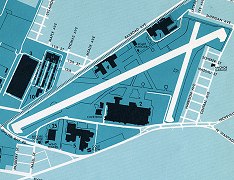| |||||||||||||||||||||||||||||||||||||||||||||||

Ray Eschert with my LM-10 replica patch alongside one of his original LM-10 decals 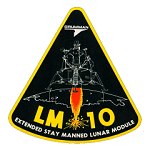
Ray's Grumman LM-10 insignia Ray Eschert was responsible for producing the design of the Grumman LM-10 insignia back in 1969 when he worked at Grumman's Space Craft Assembly & Test (S/CAT) division at their Bethpage, Long Island, NY, facility. The background of Grumman Aerospace's Lunar Module S/CAT division is well documented in Frank A. Pullo's "S/CAT Remembered" website, now hosted on Eric Hartwell's space history site. What follows is a brief overview of Ray's days at S/CAT, including the story of how the LM-10 insignia came to be created, and how it was used at the time. |
|||||||||||||||||||||||||||||||||||||||||||||||
Ray Eschert's story | |||||||||||||||||||||||||||||||||||||||||||||||
|
Ray Eschert grew up within sight of Grumman's 600 acre Bethpage, Long Island, NY plant. My parents purchased their first home across from Grumman on Hicksville road and lived in it from 1954 until 1964 when they moved to a new home across from Grumman's runway along Central Ave. I used to watch them work on the old fighters from WWII as they had a vintage plane club. After serving a term in the Army, 21 year old Ray Eschert began looking for employment around his hometown. It was December 1967 and Ray's wife was expecting their first child. We moved in with my parents until I could find work and a place of our own. I had one or two job leads from friends and interviewed for them. In the mean time my father who was a plant manager for a small speciality fastner company was looking into a possible job with that firm. They did not have an opening but through an exployment contact he had at Grumman he arranged an interview since Grumman was very active in hiring. Grumman was at that time a firm where they tended to interview & hire mostly those who had relatives or friends who could recommend you. Remember life was different in 1967 and that was not uncommon to find when looking for a job. I made contact with the Grumman employment office and requested the person my father had spoken to. Did the interview, filled out the forms and was told someone would contact me. I was called for a second interview with a department manager for engineering & engineering support. Just prior to that I had been offered a job with one of the companies I had interviewed with doing record keeping in the purchasing department at a salary of $100 a week. I had a week to decide so I wanted to see where I stood with Grumman as there would be more of a career with them. At the completion of the second Grumman interview the department head called down to one of his administrators who was looking for help and had me go directly to him for another interview in the trailer complex at Plant 5 where the LMs where being constructed. I met with Dick Seleska and he talked to me about the job requirements in broad terms, asked how or who I knew at Grumman. In that exchange I remembered that our HS nurse had once been a nurse at Grumman. She was also at one time my parents' next door neighbor. I mentioned my father's connection and her name. Bingo! He remembered her and asked how she was doing. He asked about the salary I anticipated and I shot for $110 ($10 better than the other offer I was sitting on). He gave me a smile and said I would have to start at $125. Told me once they did a security check they would advise me if I had the job. I left floating on air and could not wait to let my wife know about the additional money. In a few days I was told to come back and complete some paperwork. Afterwards I was told to report on the next Monday to the administrator at the Plant 5 trailer complex at 7 AM. I did, and started working that day in the Information & Documentation Center or IDC. I was introduced around given a brief walking tour of the complex and got to see the clean room or the final assembly and test area. Toured inside wearing the smock and hat. In general a welcome aboard. We were 24/7 and my first day was the start of my tenure at Grumman. This was the end of January, or start of February, 1968. My first position had me working as a tech aid in what was called the IDC or Information & Documentation Center. The IDC was staffed 24/7 with the day shift staring at 6AM and ending at 6PM and the night shift covering from 6PM to 6AM. Both fully staffed except for Sundays when we would pull 6 hours shifts with only 1 person covering the department. We had to validate every single test and work sheet required to document what was being done to the vehicles. If they placed a panel we had to make sure it noted correctly on the sheet check that both the approved QC inspectors from Grumman and NASA had signed off on it along with the respective crew leaders or system managers. All of these where filed and then micro filmed so there was a record that could be checked on should there be a problem. Picture having to record things like 'removed coupling from fluid line part number 1111223 at Panel 3 of descent vehicle. Turned coupling 4 time coupling closewise to remove and verify o-ring.' That would be on one Test Preparation & Production Sheet (TPMS). Validate all signatures and make a copy for records. A few minutes later we would get a second TPMS recording that the coupling had been refitted making copy and returned by turning clockwise 4 turns ... There was a constant flow of information being recorded. Being reasonably good at what I did for the IDC they moved me up to being a crew leader for ground support equipment. I had a few guys working for me and we had to make sure the test equipment was calibrated and ready when needed, constantly moving stuff around to the different vehicles that were in production. We ran 3 vehicles at a time all in different phases of construction or testing. During one test of an LM vehicle (I think it was LM-6) they had to remove a section of the skin to make a repair. Wanting to pick up the sequence where the problem happened rather than having to shut down and restart from scratch, our Grumman QC guys got the NASA QC to agree to using aluminum foil as a temporary cover for the skin. Someone drove to an A&P grocery store to buy a roll of it. The test finished and replacement skin was made up and used to replace the aluminum foil wrap. 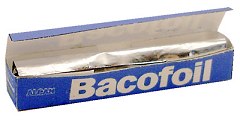
Kapton foil's secret revealed? 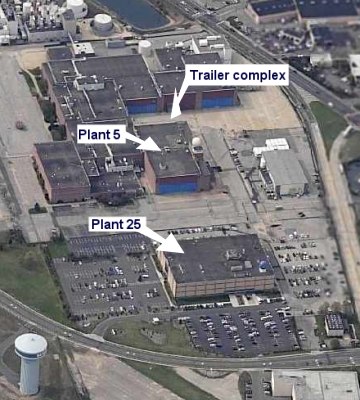
Aerial view of part of the former Grumman site at Bethpage, Long Island, NY This is looking down on Plant 5, with the blue door and round silver dome. The vehicles final assembly and test was done in the plant 5 clean room. The area between that building and the set of triple blue doors is where the trailer complex was. The trailers were directly connected to Plant 5, and the living trailer was attached to the last trailer before going into the plant itself. The building closest to the bottom was Plant 25 where a lot of the design engineers worked for all of the grumman projects including the LM. On the right there's a fork in the road system with a grass island at the 'V'. If you were to cross over that grass section going to the right that is where Plant 39 was. We had a gate right there to enter into the parking lot and directly into the trailer complex. In fact I always entered the Grumman site via the Central Ave gate and drove along the runway road to get around to the plant 5 trailer complex. I had a 68 fast back mustang muscle car and when I drove to work on Sundays that was mine and some others' private test road. 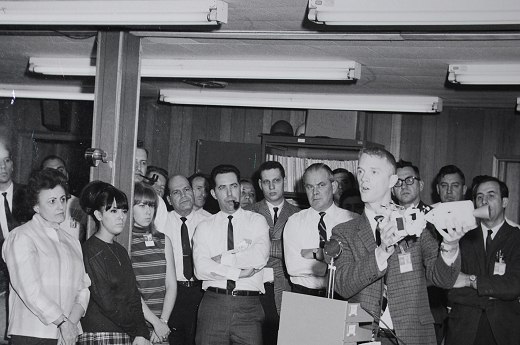 Lunar Module Pilot Rusty Schweickart describes how Grumman's LM-3 spacecraft will be flown during the upcoming Apollo 9 mission. Apollo 9 astronauts James McDivitt and Rusty Schweickart were in town to show us how the first earth test was going to work, undocking and then re docking. I've been told that this collection of photos taken by NASA are the only pictures showing up close the people in both the engineering and assembly teams together. It is also the only one showing details of the trailer complex, or at least a small corner of it, and it is a time warp because there are no computers and people are smoking. God how did we manage to live through all of that and land on the moon? After working on LM-4, Ray began work on LM-7, the Apollo 13 Lunar Module Aquarius. When LM-4 shipped my team was moving up to take on LM-7 and as there were always promotions or shifting of people when this happened I was promoted to engineer aide on LM-4 at the point it was shipping and then I moved up a notch to engineer scheduling on LM-7, working with the scheduling engineer directly in keeping the flow charts posted daily to track the vehicle through the entire process. I made a suggestion on using magnetic tape to plot the scheduling board rather than constantly having to erase and repost information. It was adopted and I got a Project Sterling Award for that. I think that was what helped me move up to SCAT Administrator for LM-10. The LM-7 administrator felt I had done a good job and deserved to replace him since he was also moving up to Plant administrator when we moved into Plant 39 with the SCAT teams. Tom Gillen the SCAT manager for LM-10 interviewed me and offered me the job. In the meantime the LM-7 vehicle shipped from Bethpage to the Cape in 1970. We had a great ship party. On the LM-7 shipping I was actually given the assignment of obtaining the signature of the head NASA representative on the final sell off paper work which transferred ownership of the Apollo 13 Lunar Module from Grumman to NASA after the vehicle was loaded on the Guppy plane that flew it to the Cape. Somehow it was just a normal task and I was asked to do it. Honestly a lot of what we did was just JOBS. We did what we did with pride and with an understanding lives were in the balance. But it was at a certain level just every day jobs getting done. 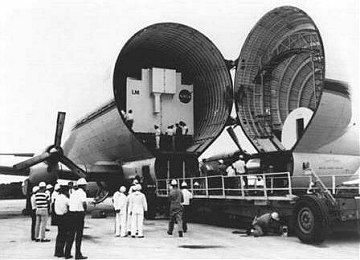 One of Grumman's Lunar Modules being loaded into the Super Guppy 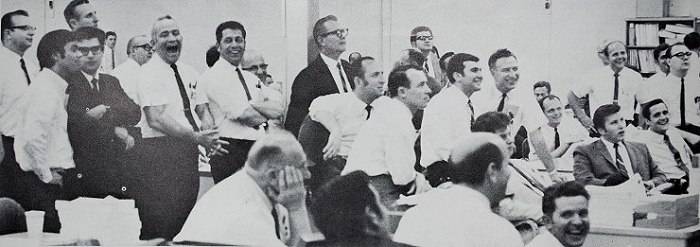
Grumman gathered in July 1969 to watch their LM-5 spacecraft (aka Apollo 11's "Eagle") landing on the moon. Did Ray ever meet any of the astronauts in person during his time at Grumman? The night shift had a retired naval chief petty officer running the shift. He performed a great service in addition to the normal work in that he ran the all night coffee concession as the vending machines were drained by that time. He had one guy make runs to the local stores getting bagels and rolls and keeping the coffee urns brewing. He charged a dime for coffee and 15 cents for the grub. On the day shift on the weekends we would provide the same for the day guys. There was mobile home trailer the astronauts used that was next to the Trailer complex. That's how I got to know Fred Haise as he came in one morning half asleep needing some coffee. He was a penny short when he handed me the money. I pocketed his nickel and 4 pennies and threw in a dime for him. I still have the 9 cents, as I told him when I met him again a few years ago. 1969 saw the startup of LM-10, the first Extended Stay Lunar Module which would go on to fly as Apollo 15's Falcon, with Ray working as the LM-10 S/CAT Team Administrator. 
This picture has several people not just from LM-10 but others. Tom had instructed me that morning about them coming over from the in-house Grumman magazine to take pictures. He had me round up not just his people to attend but members of the other teams so the room would be packed. So how did Ray end up being responisble for producing the design of the LM-10 insignia? It somehow became a tradition with each of the S/CAT Teams to design their own decals. The Team Manager would decide how that was done. On LM-10 Tom Gillen just asked me to come up with a design. I suggested that we capture the shape of the LEM with a view of the setting where the vehicle would land. I went with a black background to highlight the burn affect on the landing. After Tom approved it I took the idea to the in house graphic art people who always did a black & white rendering first for approval. Once that was done they worked up a color version for final approval. We had hundreds of the decals done along with standard sized heavy paper ones which were used mostly for inserting as front covers for the binders / loose leaf books used by the departments and individuals on the team and on the manufacturing & assembly floor. I gave Tom a box of decals and insert sheets for him to give out and kept the remaining boxes to do the same. I doled out all of these to the department heads and assistant sub system leaders. Many of the decals when to tool boxes, with some having a collection of them. My now 42 year old son placed several on his Hot Wheel Toy Bike. 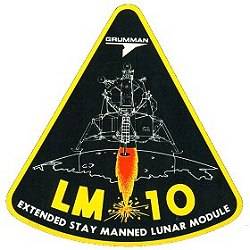
Does Ray remember any embroidered patches being produced at the time of the LM-10 insignia, or any of the other LM designs? I can tell you we did not have patches that I saw or was aware of done at the Bethpage site. I know there were some done at the cape but those had the Apollo ID. I never saw a logo for LM-13 either. Remember once NASA bought them the LM identification was gone. They were only LM numbers during production. The Grumman Lunar Module workforce was at its peak in around 1969, with close to 7,000 empolyees working on the project at Bethpage, but as the end of the Apollo program approached work on the Lunar Modules began to wind down. Once we made the initial moon landing reductions in force started to hit. Every Friday morning I would receive a list of employees who were being let go. Grumman had added thousands of engineers, techs, OC and assembly workers. Plus we were loaded with what we called job shoppers who contracted with Grumman with specific skills. At lunch I would arrange for boxes to be placed at their desks so when they returned to work they knew it was packing time. This reduction in force (RIF) was picking up speed since we would be reducing from 3 vehicles in production to only 2 when LM-10 shipped. Tom was honest with me since the other two administrators had years more time with the company. He shopped me around and found a position in in-house expediting. Same pay but a serious demotion in title. I knew this might only buy time as many of the people were moving back to the plane side of production and they had better contacts and seniority. I talked this over with my wife, took an honest look and did not see a real future. I started interviewing and Tom gave me plenty of time to do that. AT&T had openings as they were in a growth mode with the local operating company. I applied and was picked up quickly in part because of my Grumman experience and having done my military service. To help out I agreed (in late 1970) to be a RIF helping save, I hoped, another person's job. The vehicle had shipped by then and I helped transition the remaining team to LM-13. Had a great going away party and stayed in touch after joining NYTelephone by stopping by the plant after work or on my days off. Today Ray does Junior High School presentations on his time at Grumman, sharing stories on the vehicles and their production. He was also interviewed by two TV stations a few years ago and his local paper ran an article about him in 2010. Looking back on those years today, how does he see his time at Grumman? It was the greatest job I ever had, and I'm glad to have been a part of what is now history. |
|||||||||||||||||||||||||||||||||||||||||||||||
|
| |||||||||||||||||||||||||||||||||||||||||||||||
